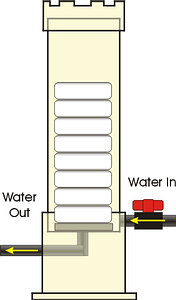Chlorination is the most common form of disinfection as it is inexpensive to install and simple to manage. Chlorine is available in solid, liquid and gas forms. Large municipal treatment plants may choose gaseous chlorine due to the cost savings, but there are many special health and safety requirements. For the purposes of small- to medium-sized onsite wastewater systems, chlorine in the form of liquid or solid is presented here. Solid pellets or liquid bleach are more popular for smaller systems.
Whichever form is used, three factors are important when designing chlorine systems:
- Mixing: Thorough mixing is important for chlorination to ensure that the chemical comes in contact with the water as much as possible. The better the mixing, the more effective the chlorination activities will be. Often, a series of baffles thoroughly mixes the effluent and chlorine as it flows through the discharge piping.
- Detention time: A minimum of 20 minutes of contact time must be provided for chlorination to function properly.
- Dosage: A proper dose of between .2 to 2 milligrams per liter is required to disinfect effluent to levels suitable for discharge. The proper dosage is determined by the amount of suspended solids in the wastewater effluent. Bacteria tend to be protected from the effect of the chlorine if there are many solids.
The following are two methods of chlorination most common for onsite wastewater treatment systems:
Erosion chlorinators
Chlorine in the solid form is commercially available in tablets that can be loaded into feeders plumbed in line with the effluent piping. As the effluent passes through the feed tube and contacts the pellets, a dose of chlorine is imparted to the effluent as the pellets erode. In a typical erosion style chlorinator, such as the one pictured to the left, chlorine is added to the wastewater as tablets dissolve. Chlorine tablets tend to cake in the moist environment, so remove and clean stacks every 2 to 3 months for best results.
Liquid chlorinators
Liquid chlorine is readily available in the form of household bleach, or sodium hypochlorite, usually at a 5% concentration. The chlorine solution for the liquid disinfection unit is prepared in a product tank where the operator mixes a predetermined amount of water and bleach together to achieve the proper concentration. A metering pump is placed in the tank and a feed line connected to the effluent discharge pipe. The dosing pump has a variable discharge, so the operator can cause more solution to be mixed with the effluent to be disinfected. Total coliform tests will verify the results.
To the right is a schematic diagram of a liquid chlorinator. The basin contains the chlorine solution, which can be made from a 2 to 1 ratio of household bleach mixed with water. The metering pump at the top of the basin sends doses of chlorine to the effluent where it is mixed to achieve the desired concentration. Use a swimming pool test kit to verify the chlorine.
